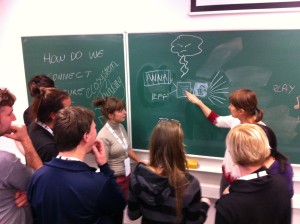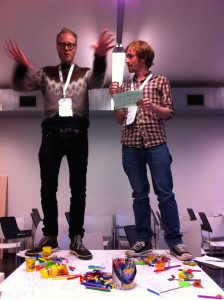Researching Reboot Stories’ experiments with open design and story I came to think of it as Purposeful Storytelling. Stories have long been used for the purpose to inform, sell or persuade, but we’re onto something that involves story to ignite action and THEN do all of the above. I mean using storytelling to solve problems, to create a fun experiential learning environment and use it as a tool to convey a complex solution.
 Lance Weiler, Jorgen van der Sloot and I played a bit with designs and prototyping sessions. Our 60-minute Open Design Challenge (ODC) is a little bit different each time since we’re refining the process with each session. But we always use storytelling, game mechanics and collaboration to design around a Wish for The Future.
Lance Weiler, Jorgen van der Sloot and I played a bit with designs and prototyping sessions. Our 60-minute Open Design Challenge (ODC) is a little bit different each time since we’re refining the process with each session. But we always use storytelling, game mechanics and collaboration to design around a Wish for The Future.
The ODC has three purposes.
1. participants experience what agility and collaboration means in today’s global culture industry
2. we R&D a system to solve problems by using collaboration, game mechanics and story
3. we test and refine storytelling as way to transfer knowledge, create empathy for content and call to action
We developed two versions, one to ideate solutions to complex problems and the other one to co-design a transmedia storyworld. Here’s a rundown of how we did the latter – a StorySprint – at DIY Days Ghent.
S tart absurd.
tart absurd.
First, the entire group had 4 minutes to generate 100 wishes around the premise to make the world work for 100% of humanity. Yep. We broke the group down into eight categories (urbanization, economy, education, humanity, culture, health, sustainability, government) to have each group focus on one area. A couple of minute later, we read out the wishes and decided the best wish collectively by cheering. Then – in the same manner – we turned the wish into a design question and a theme for our story.
“Attempting the impossible widens the mind. Lateral thinking happens when you can’t possibly imagine an immediate answer to a question.”
Simulate interdisciplinarity.
Then we broke out into three groups: one would build a prototype that helps solving the design question; the storytellers craft a hero’s journey; the third group were the story architects. Their task was to communicate between the groups and to converge the outcomes on a storyboard. We gave every group a simple template that explained the basics of storytelling, design thinking and scribing.
 “It was paramount that everyone had a task in the process to give a sense of agency and accountability.”
“It was paramount that everyone had a task in the process to give a sense of agency and accountability.”
Utilize time pressure.
53 minutes left. Imagine everything happening at the same time: Some story architects started planning their storyboard while others chose a target audience aka stakeholders, which we communicated to the two other groups. Within the first 5 minutes the story architects received the main characters from the storytelling group, which they passed on to the prototypers after they had given their first pitch to the scribes (within first 10 minutes). Generally, nobody was allowed to talk without creating something with their hands at the same time. We provided play-doh, pens, butcher paper, paddlepops and other props. We like doing that because tactile activity enhances creativity by igniting both sides of the brain.
 “Mayhem and confusion. The ODC leaves participants partly in the unknown to simulate how reality, too, only unfolds gradually. Chaordic time pressure requires us to adapt to change flexibly and creatively.”
“Mayhem and confusion. The ODC leaves participants partly in the unknown to simulate how reality, too, only unfolds gradually. Chaordic time pressure requires us to adapt to change flexibly and creatively.”
Embrace confusion.
The idea was that prototyping and storytelling group couldn’t communicate directly, only through the story architects. This way we simulated how information gets filtered and re-interpreted – like in a collaboration between various teams in a company or creative collective.
To communicate between groups, we had storytellers and prototypers pitching to the story architects. This was combined with a narrative game, in which the answer could only be ‘yes, no or maybe’. This had the purpose that content had to be anticipated and interpreted: empathy in practice. We made sure that information didn’t always flow clearly in order to imitate real life situations. At certain points we appointed narrators to help clarifying crucial aspects, in case the scribes would get stuck.
 “Everyone has to listen closely to the sparse information they get and through anticipation of the other groups’ objectives they would learn to interpret in integrate information in an agile way that leaves room for optimization and spontaneous change.”
“Everyone has to listen closely to the sparse information they get and through anticipation of the other groups’ objectives they would learn to interpret in integrate information in an agile way that leaves room for optimization and spontaneous change.”
Converge.
The 2nd pitch later on would allow the story architects to ask questions but no answers were allowed. This had the effect that the prototypers went back and refined their work according to what was still too complex for an audience to grasp. After ten more minutes the story architects got another brief to tweak and bend story and prototype into one coherent storyboard.

“The prototype is embedded as the structural bed of the story. It supports the narrative arc that marries content and platforms.”
Pitch.
The storytellers and prototypers explained their approaches while the story architects listened and converged both pitches with annotated drawings on the wall. Then we had the story architects tell how they saw the story play out using what they had gotten from the other groups. They pitched using their storyboard, which was a scripted wall, like an RSAnimate. The outcome was so creative and intriguing that 16 participants signed up to bring the project to life.
 “We can simulate collective intelligence by ascribing each group one of the three fundamental human brain functions (cf. Peter Kruse): connect deep knowledge (storytellers) and spontaneous creativity (prototypers) by building new unexpected synapses (story architects).”
“We can simulate collective intelligence by ascribing each group one of the three fundamental human brain functions (cf. Peter Kruse): connect deep knowledge (storytellers) and spontaneous creativity (prototypers) by building new unexpected synapses (story architects).”
Genesis.
This session was developed by Ele Jansen (www.learndoshare.net, Sydney), Lance Weiler (www.rebootstories.com, New York) and Jorgen van der Sloot (www.freedomlab.org, Amsterdam). We’re refining the process further to develop a solid rapid prototyping model for experience design but also for kids as a playful approach to collaborate and to learn creative problem solving skills in conjunction with story. Results will be used on two levels: lessons learned about process feed into Ele’s PhD research and into our design for Lance’s Story Design Lab at Columbia University. They will also be published on www.learndoshare.net. The prototypes that are generated throughout each Open Design Challenge will be featured on www.wishforthefuture.com for others to develop further.










